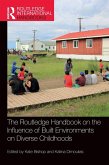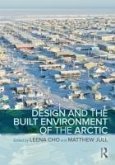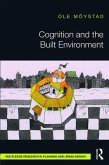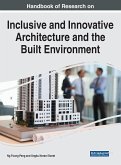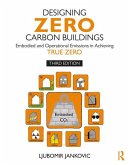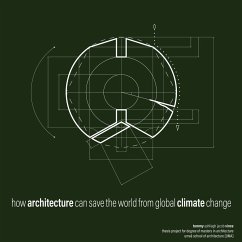The Routledge Handbook of Embodied Carbon in the Built Environment
Herausgeber: Moncaster, Alice; Azari, Rahman
The Routledge Handbook of Embodied Carbon in the Built Environment
Herausgeber: Moncaster, Alice; Azari, Rahman
- Gebundenes Buch
- Merkliste
- Auf die Merkliste
- Bewerten Bewerten
- Teilen
- Produkt teilen
- Produkterinnerung
- Produkterinnerung
This handbook explores embodied carbon across the built environment.
Andere Kunden interessierten sich auch für
![The Routledge Handbook on the Influence of Built Environments on Diverse Childhoods The Routledge Handbook on the Influence of Built Environments on Diverse Childhoods]() The Routledge Handbook on the Influence of Built Environments on Diverse Childhoods307,99 €
The Routledge Handbook on the Influence of Built Environments on Diverse Childhoods307,99 €![Design and the Built Environment of the Arctic Design and the Built Environment of the Arctic]() Design and the Built Environment of the Arctic166,99 €
Design and the Built Environment of the Arctic166,99 €![Inventing the Built Environment Inventing the Built Environment]() Juliana Yat Shun KeiInventing the Built Environment172,99 €
Juliana Yat Shun KeiInventing the Built Environment172,99 €![Cognition and the Built Environment Cognition and the Built Environment]() Ole MöystadCognition and the Built Environment202,99 €
Ole MöystadCognition and the Built Environment202,99 €![Handbook of Research on Inclusive and Innovative Architecture and the Built Environment Handbook of Research on Inclusive and Innovative Architecture and the Built Environment]() Handbook of Research on Inclusive and Innovative Architecture and the Built Environment382,99 €
Handbook of Research on Inclusive and Innovative Architecture and the Built Environment382,99 €![Designing Zero Carbon Buildings Designing Zero Carbon Buildings]() Ljubomir JankovicDesigning Zero Carbon Buildings170,99 €
Ljubomir JankovicDesigning Zero Carbon Buildings170,99 €![how architecture can save the world from global climate change how architecture can save the world from global climate change]() Tommy Vincehow architecture can save the world from global climate change78,60 €
Tommy Vincehow architecture can save the world from global climate change78,60 €-
-
-
This handbook explores embodied carbon across the built environment.
Hinweis: Dieser Artikel kann nur an eine deutsche Lieferadresse ausgeliefert werden.
Hinweis: Dieser Artikel kann nur an eine deutsche Lieferadresse ausgeliefert werden.
Produktdetails
- Produktdetails
- Verlag: Taylor & Francis Ltd
- Seitenzahl: 448
- Erscheinungstermin: 22. Dezember 2023
- Englisch
- Abmessung: 246mm x 174mm
- Gewicht: 1220g
- ISBN-13: 9781032234861
- ISBN-10: 1032234865
- Artikelnr.: 69031508
- Herstellerkennzeichnung
- Libri GmbH
- Europaallee 1
- 36244 Bad Hersfeld
- 06621 890
- Verlag: Taylor & Francis Ltd
- Seitenzahl: 448
- Erscheinungstermin: 22. Dezember 2023
- Englisch
- Abmessung: 246mm x 174mm
- Gewicht: 1220g
- ISBN-13: 9781032234861
- ISBN-10: 1032234865
- Artikelnr.: 69031508
- Herstellerkennzeichnung
- Libri GmbH
- Europaallee 1
- 36244 Bad Hersfeld
- 06621 890
Rahman Azari, PhD., is an architect, Associate Professor of architecture, and Director of the Resource and Energy Efficiency [RE2] Lab at the Pennsylvania State University (USA). Azari is also affiliated with the Penn State Institutes of Energy and the Environment (IEE), the Hamer Center for Community Design, and the Stuckeman Center for Design Computation (SCDC). Azari's research on carbon-neutral buildings and cities has been supported by research grants from the US Department of Energy (DOE), the Council on Tall Buildings and Urban Habitat (CTBUH), and the American Institute of Architects (AIA). Alice Moncaster, PhD., is a civil and structural engineer by background, whose work in industry has strongly influenced her subsequent career in academia. From July 2023 she is Professor of Sustainable Construction at the University of the West of England, and retains visiting positions at her two previous institutions, the Open University, and the University of Cambridge. She has been one of the UK experts for the International Energy Agency Annexes 57, 72, and 89 working with colleagues from around the world on developing a better understanding of embodied and whole life carbon of buildings, and on its implementation into policy and industry practice.
SECTION 1: Introduction: The embodied carbon questions and debates 1.
Introduction to this handbook - the question of embodied carbon 2.
Minimising embodied carbon: A question of politics, not percentages 3.
Climate-neutral and circular built environment - right here, right now - 4.
Net zero in buildings and construction: Use and misuse of carbon offsets 5.
Characterization of links between embodied carbon and thermal mass SECTION
2: Embodied decarbonization, approaches and policies 6. Introduction to
Section 2: National and international approaches to and policies for
decarbonisation 7. Embodied decarbonization in North America: A paradigm
shift 8. Embodied carbon in building regulation - development and
implementation in Finland, Sweden and Denmark 9. Global carbon budgets for
the built environment: How far are we to achieve a 1.5°C limit in global
warming? A Swiss example 10. The Levels framework and the Life Levels
project: Developing common and national approaches to embodied carbon in
European countries 11. Embodied emissions - knowledge building for industry
SECTION 3: Urban scale perspectives 12. Introduction to Section 3: Embodied
carbon and urban scale perspectives 13. Approaches and system boundaries
for urban carbon accounts 14. Quantifying the sunk carbon costs of cities:
A case-study of 50 years of construction in Odense, Denmark 15. Embodied
GHG in transportation infrastructure SECTION 4: Building Scale Perspectives
16. Introduction to Section 4: Embodied carbon and building scale
perspectives 17. Life cycle assessment applied to the eco-design of urban
projects in France 18. Climate and resource footprint assessment in
building information modelling: A method and indicators 19. Achieving
social justice and environmental justice in safe affordable housing through
a materials-centered, multi-level, transdisciplinary approach 20. Embodied
carbon and building retrofit; a heritage example SECTION 5: Material scale
perspectives 21. Introduction to Section 5: Embodied carbon and material
scale perspectives 22. Real and apparent variations in embodied carbon
impacts provided in EPD for construction products 23. Three windows:
Accounting for embodied resources and cultural value 24. Embodied carbon in
biogenic and earth materials: Accounting for the work of the biogeosphere
in construction materials 25. Farm to building: Catalyzing the use of
natural, net-zero, and healthier building materials
Introduction to this handbook - the question of embodied carbon 2.
Minimising embodied carbon: A question of politics, not percentages 3.
Climate-neutral and circular built environment - right here, right now - 4.
Net zero in buildings and construction: Use and misuse of carbon offsets 5.
Characterization of links between embodied carbon and thermal mass SECTION
2: Embodied decarbonization, approaches and policies 6. Introduction to
Section 2: National and international approaches to and policies for
decarbonisation 7. Embodied decarbonization in North America: A paradigm
shift 8. Embodied carbon in building regulation - development and
implementation in Finland, Sweden and Denmark 9. Global carbon budgets for
the built environment: How far are we to achieve a 1.5°C limit in global
warming? A Swiss example 10. The Levels framework and the Life Levels
project: Developing common and national approaches to embodied carbon in
European countries 11. Embodied emissions - knowledge building for industry
SECTION 3: Urban scale perspectives 12. Introduction to Section 3: Embodied
carbon and urban scale perspectives 13. Approaches and system boundaries
for urban carbon accounts 14. Quantifying the sunk carbon costs of cities:
A case-study of 50 years of construction in Odense, Denmark 15. Embodied
GHG in transportation infrastructure SECTION 4: Building Scale Perspectives
16. Introduction to Section 4: Embodied carbon and building scale
perspectives 17. Life cycle assessment applied to the eco-design of urban
projects in France 18. Climate and resource footprint assessment in
building information modelling: A method and indicators 19. Achieving
social justice and environmental justice in safe affordable housing through
a materials-centered, multi-level, transdisciplinary approach 20. Embodied
carbon and building retrofit; a heritage example SECTION 5: Material scale
perspectives 21. Introduction to Section 5: Embodied carbon and material
scale perspectives 22. Real and apparent variations in embodied carbon
impacts provided in EPD for construction products 23. Three windows:
Accounting for embodied resources and cultural value 24. Embodied carbon in
biogenic and earth materials: Accounting for the work of the biogeosphere
in construction materials 25. Farm to building: Catalyzing the use of
natural, net-zero, and healthier building materials
SECTION 1: Introduction: The embodied carbon questions and debates 1.
Introduction to this handbook - the question of embodied carbon 2.
Minimising embodied carbon: A question of politics, not percentages 3.
Climate-neutral and circular built environment - right here, right now - 4.
Net zero in buildings and construction: Use and misuse of carbon offsets 5.
Characterization of links between embodied carbon and thermal mass SECTION
2: Embodied decarbonization, approaches and policies 6. Introduction to
Section 2: National and international approaches to and policies for
decarbonisation 7. Embodied decarbonization in North America: A paradigm
shift 8. Embodied carbon in building regulation - development and
implementation in Finland, Sweden and Denmark 9. Global carbon budgets for
the built environment: How far are we to achieve a 1.5°C limit in global
warming? A Swiss example 10. The Levels framework and the Life Levels
project: Developing common and national approaches to embodied carbon in
European countries 11. Embodied emissions - knowledge building for industry
SECTION 3: Urban scale perspectives 12. Introduction to Section 3: Embodied
carbon and urban scale perspectives 13. Approaches and system boundaries
for urban carbon accounts 14. Quantifying the sunk carbon costs of cities:
A case-study of 50 years of construction in Odense, Denmark 15. Embodied
GHG in transportation infrastructure SECTION 4: Building Scale Perspectives
16. Introduction to Section 4: Embodied carbon and building scale
perspectives 17. Life cycle assessment applied to the eco-design of urban
projects in France 18. Climate and resource footprint assessment in
building information modelling: A method and indicators 19. Achieving
social justice and environmental justice in safe affordable housing through
a materials-centered, multi-level, transdisciplinary approach 20. Embodied
carbon and building retrofit; a heritage example SECTION 5: Material scale
perspectives 21. Introduction to Section 5: Embodied carbon and material
scale perspectives 22. Real and apparent variations in embodied carbon
impacts provided in EPD for construction products 23. Three windows:
Accounting for embodied resources and cultural value 24. Embodied carbon in
biogenic and earth materials: Accounting for the work of the biogeosphere
in construction materials 25. Farm to building: Catalyzing the use of
natural, net-zero, and healthier building materials
Introduction to this handbook - the question of embodied carbon 2.
Minimising embodied carbon: A question of politics, not percentages 3.
Climate-neutral and circular built environment - right here, right now - 4.
Net zero in buildings and construction: Use and misuse of carbon offsets 5.
Characterization of links between embodied carbon and thermal mass SECTION
2: Embodied decarbonization, approaches and policies 6. Introduction to
Section 2: National and international approaches to and policies for
decarbonisation 7. Embodied decarbonization in North America: A paradigm
shift 8. Embodied carbon in building regulation - development and
implementation in Finland, Sweden and Denmark 9. Global carbon budgets for
the built environment: How far are we to achieve a 1.5°C limit in global
warming? A Swiss example 10. The Levels framework and the Life Levels
project: Developing common and national approaches to embodied carbon in
European countries 11. Embodied emissions - knowledge building for industry
SECTION 3: Urban scale perspectives 12. Introduction to Section 3: Embodied
carbon and urban scale perspectives 13. Approaches and system boundaries
for urban carbon accounts 14. Quantifying the sunk carbon costs of cities:
A case-study of 50 years of construction in Odense, Denmark 15. Embodied
GHG in transportation infrastructure SECTION 4: Building Scale Perspectives
16. Introduction to Section 4: Embodied carbon and building scale
perspectives 17. Life cycle assessment applied to the eco-design of urban
projects in France 18. Climate and resource footprint assessment in
building information modelling: A method and indicators 19. Achieving
social justice and environmental justice in safe affordable housing through
a materials-centered, multi-level, transdisciplinary approach 20. Embodied
carbon and building retrofit; a heritage example SECTION 5: Material scale
perspectives 21. Introduction to Section 5: Embodied carbon and material
scale perspectives 22. Real and apparent variations in embodied carbon
impacts provided in EPD for construction products 23. Three windows:
Accounting for embodied resources and cultural value 24. Embodied carbon in
biogenic and earth materials: Accounting for the work of the biogeosphere
in construction materials 25. Farm to building: Catalyzing the use of
natural, net-zero, and healthier building materials


